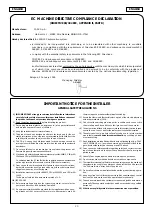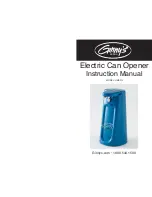
ASSEMBLY STEP 1
Fasten the Rail To the Power Unit
6
Rail
Sprocket
Rail
Assembly
Trolley
Coupling
Rail/Power Unit
Bracket
Lock Nuts
1/4"-20
Power Unit
Sprocket
Opener
Chassis
Foam Packaging
Hex Screws
1/4"-20x5/8"
ASSEMBLY STEP 2
Install the Trolley
As illustrated above, slide the trolley onto and along the
bottom of the rail until it snaps firmly in place. Be certain
to install it facing correctly: the trolley release arm must
be horizontal (lock position), with its arrow pointed
away from the power unit.
Assembly Section: Pages 6 - 7
1/4" - 20
Lock Nut
1/4" - 20 x 5/8"
Hex Screw
Hardware Shown Actual Size
• Working on a level surface, align the rail assembly with
the power unit, as shown.
• Slip the coupling over the rail sprocket.
• Slide the rail through the power unit bracket until the
coupling fits securely over the power unit sprocket.
• Align the two screw holes in the rail with those in the
power unit bracket. Insert two 1/4"-20x5/8" hex screws
and lock nuts. Tighten securely with a 7/16" socket
wrench.
NOTE: To aid in assembly and installation, replace
the foam packing around the power unit. Remove it
after Installation Step 5.
Having a Problem?
(continued)
Situation
Probable Cause & Solution
The door reverses for no
apparent reason and
opener lights don't
blink:
The door reverses for no
apparent reason and
opener lights blink for
5 seconds after
reversing:
1. Is something obstructing the door? Pull the manual release handle. Operate the door
manually. If it is unbalanced or binding, call for professional garage door service.
2. Clear any ice or snow from the garage floor area where the door closes.
3. Review the force adjustment procedures on page 25.
4. If door reverses in the fully closed position, decrease the travel limits (page 24).
Repeat the safety reverse test after adjustments to force or travel limits. The need for
occasional adjustment of the force and limit settings is normal. Weather conditions in
particular can affect door travel.
The opener lights…
don't turn on:
Replace the light bulb(s) (100 watts maximum). Use a standard neck garage door opener bulb
if regular bulb burns out.
don't turn off:
Is the Light feature on? Turn it off.
The opener strains or
maximum force is
needed to operate door:
The door may be out of balance or the springs are broken. Close the door and use the manual
release handle to disconnect the trolley. Open and close the door manually. A properly
balanced door will stay in any point of travel while being supported entirely by its springs. If
it does not, disconnect the opener and call for professional garage door service. Do not
increase the force to operate the opener.
The opener motor
hums briefly, then
won't work:
1. The garage door springs are broken. See above.
2. If the problem occurs on the first operation of the opener, door may be locked. Disable the
door lock.
Repeat the safety reverse test after the adjustment is complete.
The opener won't
operate due to power
failure:
1. Use the manual release handle to disconnect the trolley. The door can be opened and closed
manually. When power is restored, press the Door Control push bar and trolley will
automatically reconnect (unless trolley is in lockout position.) See page 28.
2. The Outside Quick Release accessory (for use on garages with no service door) disconnects
the trolley from outside the garage in case of power failure.
31
The door opens but
won't close:
1. If the opener lights blink, check the safety reversing sensor. See page 18.
2. If the opener lights do not blink and it is a new installation, check the down force. See
Adjustment Step 2, page 25. For an existing installation, see below.
Repeat the safety reverse test after the adjustment is complete.
Check the safety reversing sensor. Remove any obstruction or align the receiving eye. See
page 18.






































